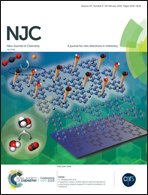A naphthalimide end capped imide-fused benzothiadiazole based small molecule acceptor for organic solar cells†
Abstract
In this study, by incorporating imide-fused benzothiadiazole (BIBT) as the electron-withdrawing core unit, for the first time we designed and synthesized a novel A1–D–A2–D–A1 type small molecule acceptor denoted BIBT-NI for organic solar cell (OSC) applications. Its thermal, optical and electrochemical properties were thoroughly investigated. Density functional theory was also applied to shed light on the molecular configuration and energy level distribution of the acceptor. This molecule exhibited a strong absorption spectrum in the range of 420–550 nm together with an optical bandgap of 2.04 eV. The inverted OSC devices based on BIBT-NI as an electron-acceptor combined with the classical polymer poly(3-hexylthiophene) (P3HT) as an electron-donor afforded an optimal power conversion efficiency of 2.11% with a comparatively high open-circuit voltage of 0.78 V. These results underscore the promising potential of BIBT as an electron-deficient building block in constructing nonfullerene acceptors for OSCs.



 Please wait while we load your content...
Please wait while we load your content...